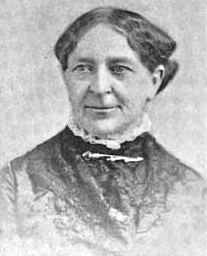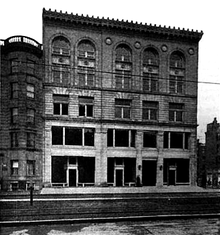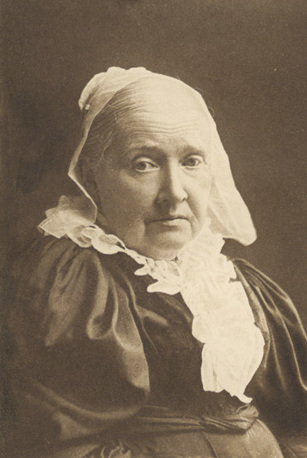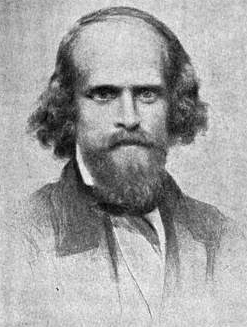The New England Women's Club (est. May 1868) of Boston, Massachusetts, was one of the two earliest women's clubs in the United States, having been founded a couple of months after Sorosis in New York City. [1] [2]
Contents


The New England Women's Club (est. May 1868) of Boston, Massachusetts, was one of the two earliest women's clubs in the United States, having been founded a couple of months after Sorosis in New York City. [1] [2]


Harriet Hanson Robinson, founder of the National Woman Suffrage Association of Massachusetts, and suffragist Caroline Severance worked with Julia Ward Howe to organize the club. [1] [3]
In 1868, "club rooms were first secured in ... the rear of the popular Tremont House. On May 30, 1868, the first meeting to introduce the New England Woman's Club to the public was held in Chickering Hall." [2] The club incorporated in 1887; Sarah H. Bradford, Ednah Dow Littlehale Cheney, Lucy Goddard, Abby W. May, L. M. Peabody, Harriet M. Pittman, Harriet Winslow Sewall, and Kate Gannett Wells served as signatories. By 1893, some 340 members belonged to the club. [4] Publisher and activist Josephine St. Pierre Ruffin was the first African-American woman to join the organization, when she joined in the mid-1890s. [5]
Although the club was run by and for women, men were allowed to join. A few men had attended the initial meeting, including Ralph Waldo Emerson, James Freeman Clarke, Octavius Brooks Frothingham, Thomas Wentworth Higginson, and Amos Bronson Alcott. [2] Of these, Emerson, Clarke, and Higginson all became members. [6]
At this time, in Boston, there existed a few other clubs for women, including "the Saturday Morning Club, the Brains Club and the Young Ladies Club, the members of which are in general high-toned persons, interested in intellectual and philanthropic matters." [7] The goal of the New England Women's Club was to "provide a suitable place of meeting in Boston for the convenience of its members, and to promote social enjoyment and general improvement." Committees oversaw club activities with regard to "Art and Literature," "Discussions," "Education," and "Work." "Monday Teas" were held every week. [8] In its first year, club members set about organizing a horticultural school. [9]
Lectures occurred frequently, given by both club members and invited speakers. Among the many lecturers in the club's first decades were: Louis Agassiz, Amos Bronson Alcott, George Thorndike Angell, Richard Henry Dana Jr., Ralph Waldo Emerson, Annie Adams Fields, James T. Fields, William Lloyd Garrison, Edward Everett Hale, Thomas Wentworth Higginson, Oliver Wendell Holmes Sr., Henry James, and Mary Tyler Peabody Mann. [4]

Around 1903, the club moved its headquarters from Park Street to the newly constructed New Century Building on Huntington Avenue, designed by architect Josephine Wright Chapman. [10] In 1909, the club moved into the newly constructed Chauncy Hall Building at 585 Boylston Street, and it was there as late as 1922. [11] [12]

Julia Ward Howe was an American author and poet, known for writing the "Battle Hymn of the Republic" and the original 1870 pacifist Mother's Day Proclamation. She was also an advocate for abolitionism and a social activist, particularly for women's suffrage.
Josephine St. Pierre Ruffin was a publisher, journalist, civil rights leader, suffragist, and editor of the Woman's Era, the first national newspaper published by and for African-American women.

Annie Adams Fields was an American writer. Among her writings are collections of poetry and essays as well as several memoirs and biographies of her literary acquaintances. She was also interested in philanthropic work, in which she found her greatest pleasure. Her later years were spent as a companion to author Sarah Orne Jewett.

Southworth & Hawes was an early photographic firm in Boston, 1843–1863. Its partners, Albert Sands Southworth (1811–1894) and Josiah Johnson Hawes (1808–1901), have been hailed as the first great American masters of photography, whose work elevated photographic portraits to the level of fine art. Their images are prominent in every major book and collection of early American photography.

The General Federation of Women's Clubs (GFWC), founded in 1890 during the Progressive Movement, is a federation of over 3,000 women's clubs in the United States which promote civic improvements through volunteer service. Many of its activities and service projects are done independently by local clubs through their communities or GFWC's national partnerships. GFWC maintains nearly 70,000 members throughout the United States and internationally. GFWC remains one of the world's largest and oldest nonpartisan, nondenominational, women's volunteer service organizations. The GFWC headquarters is located in Washington, D.C.

Ednah Dow Littlehale Cheney was an American writer, reformer, and philanthropist.

Seth Wells Cheney was an American artist and a pioneer of crayon work in the United States.
Cheney, originally de Cheney, is a toponymic surname of Old French origin, introduced into England by the Normans.

Harriet Winslow Sewall was an American poet, and editor of the collected letters of Lydia Maria Child.

Caroline Maria Seymour Severance (1820–1914) was an American abolitionist, suffragist, and founder of women's clubs.
John Cheney (1801-1885) was an engraver in Boston, Massachusetts, and Philadelphia in the 19th century. He travelled in Europe in the 1830s. His brothers were Ward Cheney and Seth Wells Cheney, who married the writer, Ednah Dow Littlehale Cheney. Examples of Cheney's work are in the Museum of Fine Arts, Boston. In 1833, he was elected into the National Academy of Design as an Honorary Academician.

The New England Woman Suffrage Association (NEWSA) was established in November 1868 to campaign for the right of women to vote in the U.S. Its principal leaders were Julia Ward Howe, its first president, and Lucy Stone, who later became president. It was active until 1920, when suffrage for women was secured by the Nineteenth Amendment to the U.S. Constitution.
The Massachusetts Woman Suffrage Association (MWSA) was an American organization devoted to women's suffrage in Massachusetts. It was active from 1870 to 1919.
The Boston Women's Heritage Trail is a series of walking tours in Boston, Massachusetts, leading past sites important to Boston women's history. The tours wind through several neighborhoods, including the Back Bay and Beacon Hill, commemorating women such as Abigail Adams, Amelia Earhart, and Phillis Wheatley. The guidebook includes seven walks and introduces more than 200 Boston women.

Florida Ruffin Ridley was an African-American civil rights activist, suffragist, teacher, writer, and editor from Boston, Massachusetts. She was one of the first black public schoolteachers in Boston, and edited The Woman's Era, the country's first newspaper published by and for African-American women.

The Woman's Era was the first national newspaper published by and for black women in the United States. Originally established as a monthly Boston newspaper, it became distributed nationally in 1894 and ran until January 1897, with Josephine St. Pierre Ruffin as editor and publisher. The Woman's Era played an important role in the national African American women's club movement.

Mary Evans Wilson (1866-1928) was one of Boston's leading civil rights activists. She was a founding member of the Boston branch of the National Association for the Advancement of Colored People, and the founder of the Women's Service Club.

The New England Woman's Press Association (NEWPA) was founded by six Boston newspaper women in 1885 and incorporated in 1890. By the turn of the century it had over 150 members. NEWPA sought not only to bring female colleagues together and further their careers in a male-dominated field, but to use the power of the press for the good of society. The group raised funds for charity and supported women's suffrage and other political causes.

Samuel Edmund Sewall (1799–1888) was an American lawyer, abolitionist, and suffragist. He co-founded the Massachusetts Anti-Slavery Society, lent his legal expertise to the Underground Railroad, and served a term in the Massachusetts Senate as a Free-Soiler.
Julia O. Henson was an American social justice activist who founded organizations to support African American troops during World War II (1914–1918) and to provide opportunities for African Americans to thrive through the founding of the National Association for the Advancement of Colored People (NAACP). She donated the building for the Harriet Tubman House in Boston in 1904.